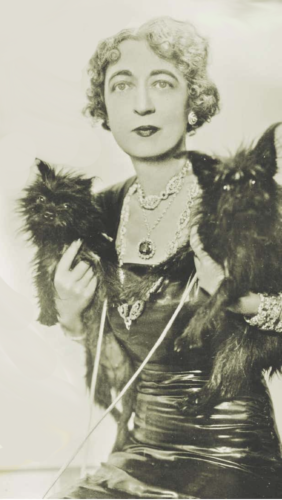
She was the last private owner of the fabulous 45.52 carat Hope Diamond, but Evalyn Walsh McLean dismissed as nonsense the curse associated with the gem. According to legend, misery and death befell not only the owner of the blue diamond, but anyone who touched it, this, the punishment for it having been stolen from one of the eyes of a statue of the Hindu goddess, Sita.
The man who stole the diamond from the statue in India, Jean Baptiste Tavernier, would eventually be torn apart by wild dogs on a trip to Russia (though one source writes that the story is a myth, and that Tavernier retired to Russia where he died peacefully).
Before his death, Tavernier had sold the diamond to Louis XIV. Louis would die of gangrene, and all of his legitimate children died in childhood, except for one.
Nicholas Fouquet, who had worked for King Louis XIV, was said to have worn the diamond on special occasions, but he fell out of favor with the king and was sentenced to life imprisonment in the fortress of Pignerol. Some people believe that he was the real Man in the Iron Mask.
Princess de Lamballe, the closest confident of another Hope Diamond owner, Marie Antoinette, was killed by a mob. She’d been hit with a hammer, decapitated, stripped, and disemboweled, her head impaled on a pike and carried to Marie Antoinette’s prison window before Antoinette and her husband (Louis XIV’s grandson, Louis XVI) were beheaded during the French Revolution.
Knowledge of the whereabouts of the blue diamond following the revolution is murky but it resurfaced here and there, and by the time Pierre Cartier bought it, it had had several owners. Cartier sold the diamond to 24 year old Evalyn Walsh McLean, the feisty only-daughter of an Irish immigrant who struck gold in a very big way.
Though Evalyn had poo-poohed the misery associated with the diamond, she took the precaution of having have a priest bless the gem. Afterwards, Evalyn was nearly inseparable from the stone. She wore it whether she was attending a concert, weeding her garden, or wearing a swimsuit. She even put it on her dog’s collar once for a party.
Was there a price to be paid?
Evalyn’s nine year old son, Vinson, was hit and killed by a car in front of their estate. Her husband, Ned, a heavy drinker, took on a mistress, was eventually declared insane, and lived in a mental institution until his death in 1941. In 1946, Evalyn’s only daughter, Evalyn McLean Reynolds, died of a drug overdose at the age of twenty-five, a loss from which Evalyn, the mother, never recovered. She died of pneumonia shortly after, though some say she ended her life with an overdose of sleeping pills. Two years after her death, Evalyn’s jewelry was sold to settle debts from her estate. The diamond would end up with Harry Winston, a New York jeweler who donated it to the Smithsonian Institution in 1958 (some say to end the curse). The Hope diamond is currently on display as part of the National Gem and Mineral Collection in the National Museum of Natural History, but James Todd, the postman who delivered the diamond to the museum, was hit by a truck (not fatally), his wife and dog died not long after, and his home caught fire.
We can only presume that Evalyn Walsh McLean did know some happiness. The American mining heiress and socialite was the era’s consummate socialite who wrote in her memoir: “If I had a dog, I wanted it to be a dog people turned to stare at.”
In 1937, she got her wish with the purchase of a pair of Affenpinschers bred by Mrs. Bessie Mally of Zwergteufel (Dwarf Devil) kennel. Indeed, the first time that most American heard of the breed, let alone see, it was in a photo taken of Evalyn wearing the Hope Diamond and holding her two Affenpinschers.
Evalyn, an ardent dog lover who had also owned a Poodle, a Saint Bernard and a Great Dane, had raised many puppies before, but she was able to breed only one Affenpinscher litter. Still, her high profile as a social lioness brought attention to the breed at a time it could use it. Though there was a spike in Affenpinscher registrations just before World War I, numbers fell during the War, and WWII left little interest in the breed at all.
The Affenpinscher was admitted to the American Kennel Club’s Stud Book in 1936, and a standard based on the German standard at that time was accepted. The first Affenpinschers entered in the Stud Book, three bitches and a dog, were all German imports owned by Mrs. Bessie Mally of Cicero, the same Mrs. Mally who had sold a pair of Affenpinschers to Evalyn Walsh McLean.
Those interested in the breed will want to read a piece wonderfully written by Amy Fernandez that appeared in the November/December 2017 issue Canine Chronicle.
Image of Evalyn Walsh McLean with her Hope Diamond and two Affenpinschers
